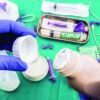![1]()
News
COVID-19: Managing resource crunch and ethical challenges
April 14, 2020
Allocation of health care resources should be made according to a plan, by a triage team, and not left to front-line clinicians.
![1]()
News
COVID-19 and surge capacity in U.S. hospitals
April 9, 2020
Independently preparing for the surge capacity needed to face COVID-19 may be infeasible for some hospitals.
![1]()
News
Is protocol-driven COVID-19 respiratory therapy doing more harm than good?
April 6, 2020
“This is a kind of disease in which you don’t have to follow the protocol – you have to follow the physiology. Unfortunately, many, many doctors around the world cannot think outside the protocol,” said Dr. Luciano Gattinoni.
![1]()
News
Which tube placement is best for a patient requiring enteral nutrition?
April 2, 2020
Early enteral nutrition is essential in hospitalized patients unable to maintain oral nutrition.
News
COVID-19: More hydroxychloroquine data from France, more questions
April 1, 2020
Dr. Benjamin Davido, an infectious disease specialist at Raymond-Poincaré Hospital in Garches, Paris, discusses the implications of new data on the use of hydroxychloroquine in patients with COVID-19.
News
Top 10 must-dos in ICU in COVID-19 include prone ventilation
March 31, 2020
One expert involved in the development of the first international guidelines on the management of critically ill patients with COVID-19 highlights the essential recommendations and explains the rationale behind prone ventilation.
Video
Critical care and COVID-19: Dr. Matt Aldrich
March 30, 2020
Matt Aldrich, MD, medical director of critical care at UCSF Health in San Francisco, speaks about critical care issues in COVID-19.
![1]()
Article
Before the COVID-19 surge hits your facility, take steps to boost capacity
March 28, 2020
Communication about resource allocation can ease workforce anxiety amid the coronavirus pandemic.
![1]()
News
At U.S. Ground Zero for coronavirus, a hospital is transformed
March 26, 2020
Hospitalists at EvergreenHealth in Kirkland, Wash., benefited from an early connection with Chinese peers.
Audio
Lessons from Seattle: Prepping a critical care system for COVID-19
March 26, 2020
From communicating with staff to managing patients with comorbidities, here’s how a major Seattle medical center is preparing.





